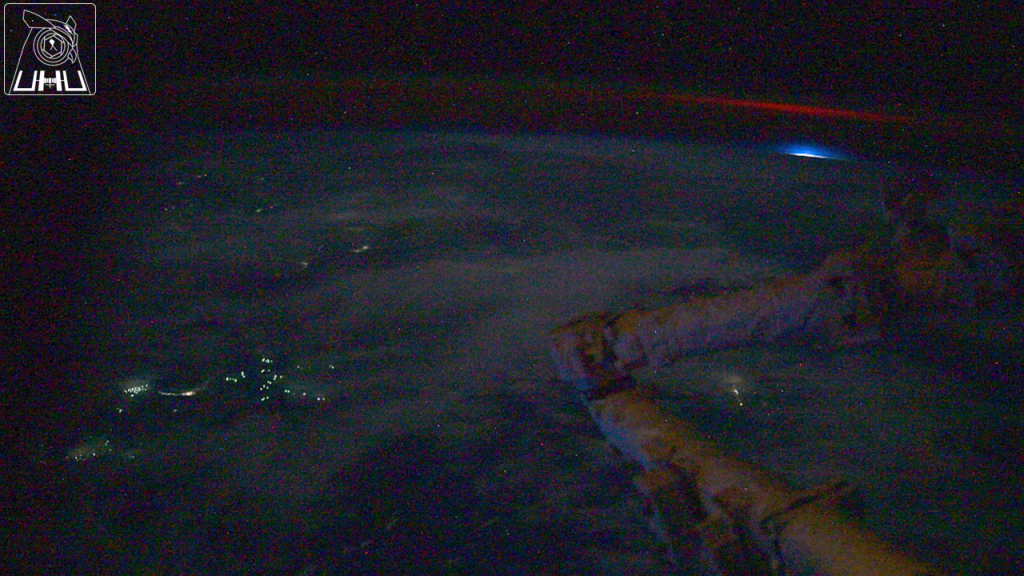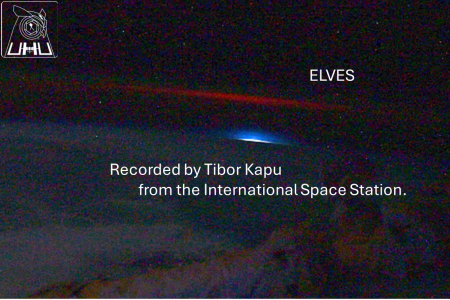The brightest ELVES phenomenon so far in the UHU experiment was captured by the Hungarian astronaut of the Ax-4 mission
New observation data are becoming available from the UHU experiment, recorded by the crew of Axiom Space’s Ax-4 mission aboard the International Space Station between June 27 and July 13. Our team continues conducting quality checks and reviewing of the video recordings, searching for TLE (Transient Luminous Events).
During the mission, we provided 8–12 potential observation possibilities per day, totaling 166 possible targets, for the astronauts on board the space station. The crew attempted observations of 26 of these targets, as permitted by their busy schedule and the observation time windows. Based on our current knowledge, 15 of these attempts resulted in video recordings. So far, seven of these were found to contain segments that provide valuable material for addressing the UHU project’s scientific objectives. When significant lightning activity is included, it is useful, for example, for evaluating the performance of different lightning detection techniques. When, in some cases, above-cloud electrical flashes are also captured, they can be studied to better understand extreme manifestations of atmospheric electricity.
Other recordings either did not contain significant electrical activity, or the footage itself was unsuitable for further analysis. In several cases, as well as in the majority of failed attempts, direct sunlight entering the station’s Cupola made meaningful observations impossible. This unfavorable condition persisted during roughly half of the Ax-4 mission, substantially reducing the number of possible nighttime observations.
Alongside the numerous lightning flashes, we have so far identified 9 ELVES events (Emission of Light and Very Low Frequency perturbations due to Electromagnetic Pulse Sources) in the recordings. ELVES are triggered by lightning discharges with extremely high peak currents (most often exceeding 100 kA). Powerful lightning makes ELVES to have sufficient brightness to be detected by the applied camera. ELVES typically occur near the edge of space, at altitudes of around 90–100 km, brightening up a thin disc or doughnut-shaped region hundreds of kilometers in diameter. ELVES alter the properties of radio waves passing through the affected region, making it possible to study both the phenomenon itself and, indirectly, the electrical recovery rates in the lower ionosphere.
On July 3, while the orbiting laboratory was passing over Malaysia and the Philippines, astronaut Tibor Kapu recorded two ELVES events near the distant horizon. The image below shows a full video frame in which the ELVES appear as a red glow beneath the greenish airglow layer. Among the 9 ELVES identified so far, this was the brightest. Remarkably, just one day later, mission commander Peggy Whitson captured ELVES in nearly the same region — the very events that were the first to be identified in the footage initially available to us.

ELVES phenomenon (red glow beneath the green airglow) and the initiating lightning flash near the horizon on July 3, 2025. Video frame (with enhanced coloring) recorded by Hungarian astronaut Tibor Kapu from the International Space Station as it was passing over Malaysia and the Philippines. The station’s robotic arm is visible in the foreground.
Ground-based observers reported mostly red sprites from various locations around the world, including Europe, during the Ax-4 mission period. Sprites are among the most spectacular elements of the TLE family, with highly diverse shapes, and are the most commonly observed from the ground. From space, however, ELVES are the most frequently detected phenomena, even though this was usually not so in earlier experiments similar to UHU. So far, UHU’s space-based campaign has yielded only ELVES detections. This (preliminary) result is not entirely surprising: sprites don’t occur all the time. They tend to occur during the late (mature) phase of a thunderstorm’s lifecycle. A few additional recordings from the mission still await detailed analysis, and we will see whether they may hold further positive surprises.




